Thermit Process | Thermit Welding Materials | Application Of Thermit Welding :: TheMech.in
Thermit Welding
Thermit welding is a fusion welding process that makes use of the intense heat produced when a mixture containing iron oxide and powdered aluminium is ignited. The reaction is based on the high affinity of aluminium is ignited.
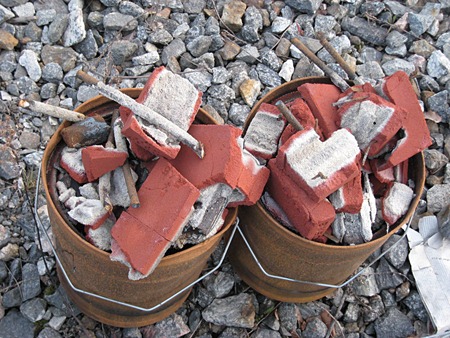
It reduces iron oxide to thermit steel and slag, like this
8Al + 3Fe3O4 – -> 9Fe + 4Al2O3 (Slag) + Heat
The superheated molten metal is poured at the desired place which on solidification forms the welded joint. The process is thus essentially a combination of casting and welding processes. The Thermit mixture consists primarily of finely divided aluminium and iron oxide in the ratio of about 1: 3 by weight. Other metal oxides that can be used in place of iron oxide include oxides of Copper, Nickel, Chromium or Manganese but Iron oxide Thermit is the most commonly used. The mixture is filled in a specially designed refractory crucible and the reaction is started by igniting the mixture with a highly inflammable powder consisting of Barium Peroxide.
When the mixture is ignited, an ignition temperature of 1150 deg Celsius is attained which initiates the main thermit reaction. The reaction is self sustaining and very rapid as it is exothermic. A temperature of the order of 3000 deg Celsius is produced resulting in super heated thermit steel. Slag being very light floats over the thermit steel thereby protecting the metal from atmospheric gases. Apart from the basic ingredients of the thermit mixture other materials may be added to produce a desired thermit melt for any specific application.
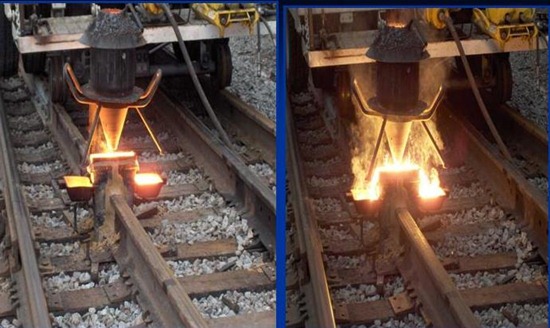
Types of Thermits used for Ferrous welding applications:
1. Plain thermit
2. Forging thermit
3. Cast iron thermit
4. Wabbler thermit
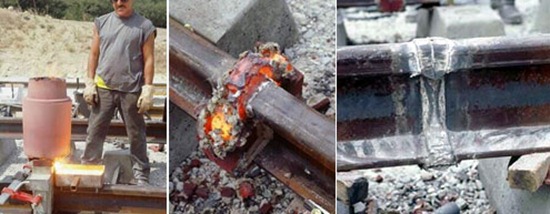
Plain Thermit:
It is a mixture of Aluminium and Iron oxide and is the base for all other thermits.
Forging Thermit:
Along with Plain thermit, Nickel, Manganese and Mild Steel are added as a mixture. It is used to weld Steel Components.
Cast Iron Thermit:
Along with Plain Thermit, Ferro-Silicon and Mild Steel are added as a mixture. They are used for Welding Iron Components.
Wabbler Thermit:
Which is specially alloyed to produce a hard, Wear resistant, Machinable Steel used for producing rolls and pinions in rolling mills.
Working Operation:
In making a thermit weld a mould is built around the sections to be welded and is preheated before use. This is done by first cutting the ends of the pieces to be welded to provide a gap with parallel faces. The gap is filled with wax which serves as a pattern for the weld. The ends of the work pieces are enclosed in a suitable flask and moulding sand rammed around the joint taking care to provide openings for the runner, riser and a heating gate.
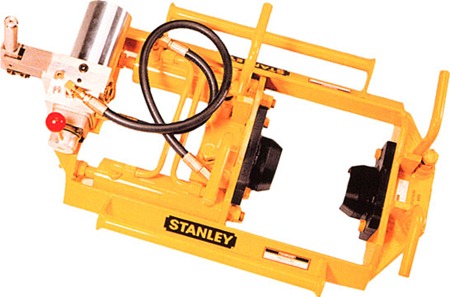
Heat is applied through the melting gate to melt out the wax and to preheat the ends of the pieces to be welded. The heating gate is then plugged with an iron plug or sand core to prevent flow of thermit metal. Thermit reaction is started in the thermit crucible and the resulting superheated steel is let in, from the bottom of the crucible. The slag being lighter floats over the molten metal in the crucible. It flows last and remains at the top of the mould where it solidifies. Clean metal enters the mould around the sections to be welded.
The temperature of the molten steel entering the mould is around 2500 degree Celsius. The heat of the superheated metal fuses and amalgamates the sections together forming joint on solidification. After the joint has solidified the mould is broken open and discarded.
The thermit welding process is useful for welding heavy sections. Though initially used primarily for joining of rails the process can be used for repair work of heavy parts like tracks, spokes of large wheels, broken motor casings, and connecting rods.
Advantages:
1. The heat necessary for welding is obtained from a chemical reaction and thus no costly power – supply is required. Therefore broken parts (rails etc.) can be welded on the site itself.
Limitations:
1. Thermit welding is applicable only to ferrous metal parts of heavy sections, i.e., mill housing and heavy rails sections.
2. The process is uneconomical If used to weld cheap metals or light parts.
—————————————————————————————
Tagged with: application of thermit welding • how thermit welding works • rail fusion welding • rail welding electrode • rail welding procedure • rail welding process • thermit process • thermit welding composition • thermit welding materials • thermite casting • thermite ignition sticks • thermite nickel • thermite powder • thermite sparking • thermite weld

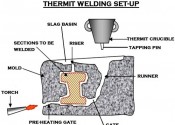
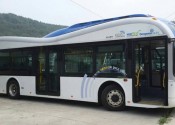
Leave a Reply